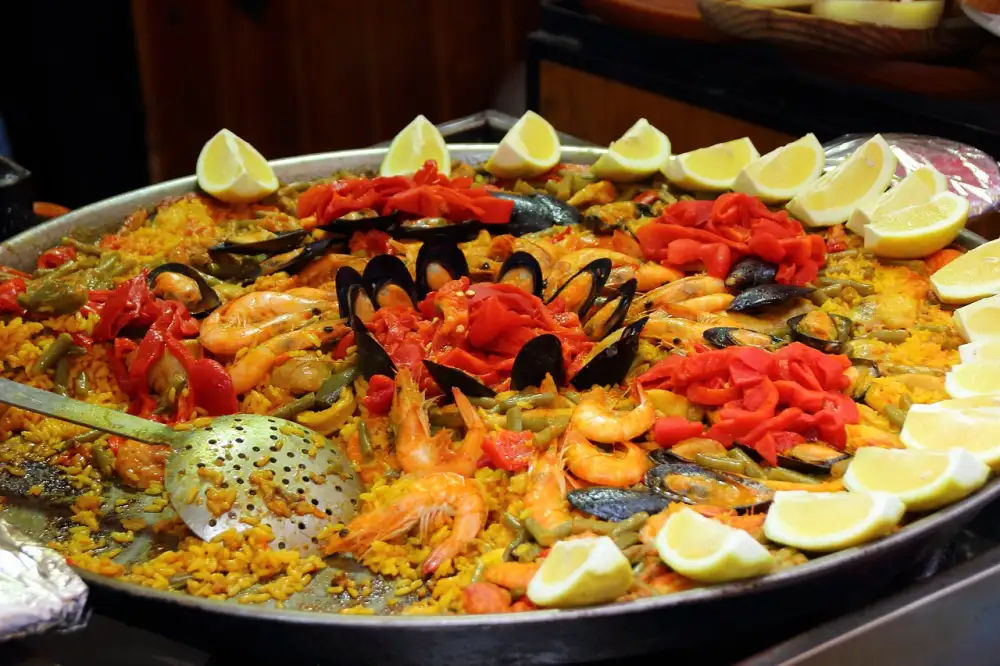Delight Your Taste Buds with Scrumptious Seafood Paella: A Spanish Delicacy to Savor

Seafood Paella is a delectable Spanish dish that combines the flavors of the sea with aromatic rice and a medley of vegetables. This mouthwatering dish is a feast for both the eyes and the taste buds, with its vibrant colors and rich flavors. Whether you are a seafood lover or simply looking to try something new, Seafood Paella is sure to delight your senses and transport you to the sunny shores of Spain. So, gather your ingredients and get ready to embark on a culinary adventure like no other!
History and Origins of Seafood Paella
Seafood paella, a beloved Spanish dish, has a rich history and fascinating origins. It originated in the Valencia region of Spain, where it was traditionally cooked over an open fire in a large, shallow pan called a "paellera." The dish was originally made by farmers and laborers using ingredients readily available to them, such as rice, saffron, vegetables, and whatever seafood they could catch.
The word "paella" actually refers to the pan itself rather than the dish. Its name is derived from the Latin word "patella," meaning flat plate or pan. Over time, as the popularity of seafood paella grew, variations with different types of seafood were created.
Seafood paella became popular outside of Spain during the 20th century when tourism increased. It quickly gained international recognition for its vibrant flavors and visually appealing presentation. Today, it is considered one of Spain's most iconic dishes and is enjoyed by people all around the world.
The history and origins of seafood paella add to its allure and make it a must-try dish for any food enthusiast or lover of Spanish cuisine.
Essential Ingredients for Seafood Paella
To create a mouthwatering seafood paella, you'll need a handful of essential ingredients. First and foremost, rice is the star of this dish. Short-grain rice, such as Bomba or Calasparra, is ideal for absorbing the flavors of the seafood and spices.
Next, you'll need an assortment of fresh seafood. Traditional options include shrimp, mussels, clams, and squid. However, feel free to experiment with other varieties like lobster or scallops to add a touch of luxury.
To infuse the paella with rich flavor, onions and garlic are a must. The sweetness of the onions complements the savory seafood perfectly. Additionally, tomatoes provide acidity and depth to the dish.
For that distinct yellow hue and earthy taste, saffron threads are essential. This prized spice adds a touch of luxury to your paella. If saffron is not readily available, you can use turmeric as a substitute.
To enhance the flavors further, paprika (both sweet and smoked) is crucial. It adds a smoky undertone that elevates the overall taste profile.
Lastly, don't forget about quality olive oil for sautéing the ingredients and adding richness to your paella. Freshly chopped parsley sprinkled on top before serving adds freshness and visual appeal.
By gathering these essential ingredients in your kitchen, you're ready to embark on a culinary adventure that will delight your taste buds!
Step-by-Step Guide to Cooking Seafood Paella
1. Heat olive oil in a large paella pan over medium heat.
2. Add diced onions and cook until translucent.
3. Stir in minced garlic and sauté for another minute.
4. Add diced tomatoes, paprika, and saffron threads to the pan, stirring well.
5. Add the rice and mix it with the other ingredients, ensuring that every grain is coated with the flavors.
6. Pour in the chicken broth and bring it to a boil.
7. Reduce the heat to low and let it simmer for about 15 minutes, without stirring.
8. Arrange your seafood (shrimp, mussels, clams) on top of the rice mixture.
9. Cover the pan with a lid and cook for an additional 10-15 minutes until the seafood is cooked through and the rice is tender.
10. Remove from heat and let it rest for a few minutes before serving.
Enjoy your delicious homemade seafood paella!
Tips and Tricks for Perfecting Seafood Paella
1. Use high-quality ingredients: Invest in fresh seafood, flavorful saffron, and authentic Spanish rice to ensure the best taste.
2. Preparing the sofrito: Take your time to cook the onions, garlic, tomatoes, and bell peppers slowly until they are soft and fragrant. This will enhance the overall flavor of the dish.
3. Sauté the rice: Before adding any liquid, toast the rice in olive oil for a few minutes. This step helps to develop a nutty flavor and gives the dish a nice texture.
4. Consistent heat distribution: Make sure your paella pan is evenly heated throughout the cooking process. This will prevent uneven cooking and ensure that all ingredients are cooked perfectly.
5. Patience is key: Avoid stirring the paella too much once you've added the liquid. Let it simmer gently without disturbance to allow the flavors to meld together.
6. Add broth gradually: Add warm broth little by little as needed, allowing each addition to be absorbed before adding more. This technique ensures that the rice cooks evenly and absorbs all the delicious flavors.
7. Don't overcook seafood: Seafood cooks quickly, so add it towards the end of cooking time to prevent it from becoming rubbery or overcooked.
8. Let it rest: Once cooked, cover your paella with a clean kitchen towel and let it rest for 5-10 minutes before serving. This allows the flavors to further develop and ensures a perfect texture.
Follow these tips and tricks to achieve a mouthwatering seafood paella that will impress your guests every time!
Variations and Adaptations of Seafood Paella
While the traditional seafood paella recipe is undeniably delicious, there are numerous variations and adaptations that can be explored to suit different tastes and dietary preferences. Here are a few popular options:
1. Mixed Paella: This variation combines various types of seafood such as shrimp, mussels, clams, and squid with other ingredients like chicken or chorizo. The addition of different proteins adds depth and complexity to the dish.
2. Vegetarian Paella: For those who prefer a plant-based option, vegetable paella is an excellent choice. It typically includes a medley of seasonal vegetables like bell peppers, artichokes, peas, and tomatoes. The flavors are still vibrant and satisfying.
3. Black Paella: Also known as "arroz negro," this adaptation gets its distinctive color from squid ink. It offers a unique flavor profile with the addition of squid or cuttlefish.
4. Seafood and Meat Combo: Some chefs experiment by combining seafood with other meats like pork or rabbit to create a fusion of flavors that tantalize the taste buds.
5. Paella Mixta: This version incorporates both seafood and meat into one dish, offering the best of both worlds for those who can't decide between the two.
These variations allow for creativity in the kitchen while still maintaining the essence of this classic Spanish delicacy. Feel free to experiment with different ingredients to create your own signature paella masterpiece!
Serving and Pairing Suggestions for Seafood Paella
Seafood paella is a versatile dish that can be enjoyed on its own or paired with other dishes to create a complete meal. Here are some serving and pairing suggestions to enhance your dining experience:
1. Serve with a side of crusty bread: The delicious flavors of the paella are best enjoyed when soaked up with a slice of crusty bread. It adds an extra layer of texture and helps balance the richness of the dish.
2. Pair with a fresh green salad: A light and refreshing green salad can provide a nice contrast to the rich and savory flavors of the paella. Opt for a simple salad dressed with lemon vinaigrette to complement the seafood.
3. Serve alongside grilled vegetables: Grilled vegetables, such as bell peppers, zucchini, and eggplant, make for a colorful and nutritious accompaniment to seafood paella. The smoky flavors from grilling add depth to the overall meal.
4. Pair with a crisp white wine: Seafood paella pairs beautifully with a crisp white wine, such as Sauvignon Blanc or Albariño. The acidity in these wines complements the seafood while cutting through the richness of the dish.
5. Serve with aioli sauce: Traditional Spanish aioli sauce made with garlic, olive oil, and lemon juice is an excellent condiment to serve alongside seafood paella. Its creamy texture and bold flavors enhance the taste of the dish.
Remember, serving suggestions can vary based on personal preferences and regional traditions. Feel free to experiment and find your own perfect pairings that will delight your taste buds!
Health Benefits of Seafood Paella
Seafood paella not only tantalizes your taste buds but also offers numerous health benefits. Packed with an array of seafood, such as shrimp, mussels, and fish, it is a great source of lean protein. These proteins help in muscle growth and repair. Additionally, seafood paella contains omega-3 fatty acids that promote heart health and reduce inflammation. The dish is also rich in vitamins and minerals like vitamin D, iron, and zinc. Moreover, the saffron used in paella has antioxidant properties that boost immunity and protect against chronic diseases. So indulge in this delectable Spanish delicacy guilt-free, knowing that it contributes to your overall well-being.
In conclusion, if you want to elevate your food game and delight your taste buds, look no further than seafood paella. This Spanish delicacy offers a burst of flavors and textures that will leave you craving for more. With its rich history, essential ingredients, and step-by-step guide, you can easily recreate this dish in your own kitchen. Don't be afraid to experiment with variations and adaptations to suit your preferences. Whether you're serving it for a special occasion or simply enjoying a delicious meal at home, seafood paella is sure to impress. So why not give it a try and experience the magic of this mouthwatering dish?
Published: 05. 12. 2023
Category: Food



